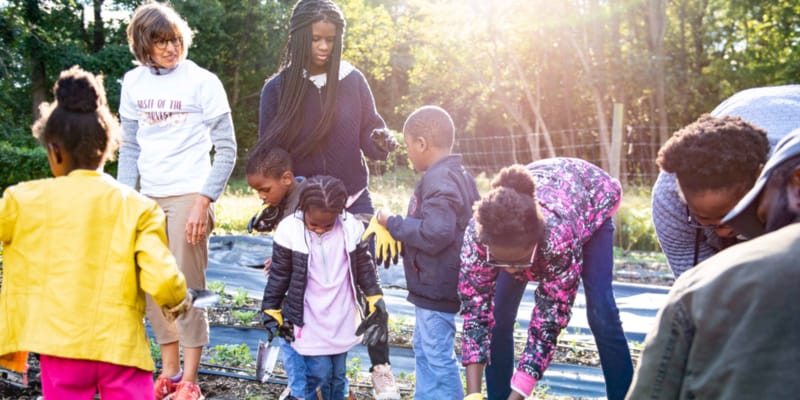Parks and public spaces
- Issue Areas
- Housing and community development
- Outcomes
- Supportive neighborhoods
Strategy overview
- Dedicating public spaces to recreation and greenery: Parks and green space can improve physical and mental health, create opportunities for residents to interact with each other, and improve environmental conditions and climate resilience.
- Encouraging physical, cultural, and social activities: Parks can be used as places for physical activity, particularly when sports or exercise equipment is installed. They can also serve as locations for community gardens or farmers markets, enhancing neighborhood access to healthy foods. Finally, public spaces are often used as venues for cultural activities, hosting classes, exhibitions, performances, and more.
- Improving the environment: Parks improve air quality, reduce temperatures, and absorb rainwater, improving public health, mitigating extreme heat, and reducing the risk and severity of flooding in surrounding areas.
- Addressing gentrification concerns: Parks often increase the value of land in nearby neighborhoods. Because of this, they can be significant accelerators of gentrification and displacement. New investments in parks and green spaces should include measures that reduce the risk of displacement and ensure that current residents benefit from new spaces, facilities, and programming.
Meta-analyses of community spaces like gardens and parks suggest meaningful health, social, and environmental gains can be achieved from properly implemented programs. Further rigorous research is needed to
A 2019 meta-narrative review of 38 urban green space interventions found significant positive environmental, health, wellbeing and social effects. Effective initiatives identified include greening of urban streets, sustainable drainage systems, greening of vacant lots, and park-based and greenway/trail interventions that paired changes with promotional campaigns.
A 2010 review of community garden case studies, interventions, and cross-sectional designs found youth gardening projects and programs were found to produce positive academic, dietary, and developmental outcomes, and overall community gardens were found to improve health outcomes and nutritional awareness.
A 2011 longitudinal study of 12 communities in Southern California found recreation programs relatively close to children’s homes were significantly and inversely associated with obesity.
Before making investments in this strategy, city and county leaders should ensure this strategy addresses local needs.
The Urban Institute has developed an indicator framework to help local leaders assess conditions related to upward mobility, identify barriers, and guide investments to address these challenges. These indicator frameworks can serve as a starting point for self-assessment, not as a comprehensive evaluation, and should be complemented by other forms of local knowledge.
The Urban Institute's Upward Mobility Framework identifies a set of key local conditions that shape communities’ ability to advance upward mobility and racial equity. Local leaders can use the Upward Mobility Framework to better understand the factors that improve upward mobility and prioritize areas of focus. Data reports for cities and counties can be created here.
Several indicators in the Upward Mobility Framework may be improved with investments in parks and public spaces. To measure these indicators and determine if investments in these interventions could help, examine the following:
- Environmental quality: Examine air quality. These data are available from the Environmental Protection Agency’s Air Quality Index.
- Safety from crime: Reported property crimes per 100,000 people and reported violent crimes per 100,000 people. These data are available from the Federal Bureau of Investigations’ Uniform Crime Reporting Program.
- Social capital: Number of membership associations per 10,000 people and the ratio of residents’ Facebook friends with higher socioeconomic status to their Facebook friends with lower socioeconomic status. These data are available from the Census Bureau’s County Business Patterns and Opportunity Insights’ Social Capital Atlas, respectively.
- Ensuring resident voices are reflected in development plans: When preparing to make new investments in parks and green spaces, leaders should engage heavily with community residents via listening sessions, co-creation sessions, and other public events. These activities help build community trust and buy-in, and they are necessary for ensuring that park design, features, and characteristics reflect the preferences of future users.
- Partner with community groups: Schools, community-based nonprofits, and other neighborhood groups can be helpful advocates for new investments in parks and are crucial in ensuring that engagement efforts reach the broadest set of neighborhood residents.
- Ensure current residents benefit from new investments: Because parks often enhance the value of surrounding land, leaders should be proactive in making investments and enacting policies that prevent displacement. Constructing new affordable housing, helping renters become homeowners, passing anti-displacement legislation, establishing value capture mechanisms, or establishing community land trusts can be helpful tactics, among others.
Resources
Evidence-based examples
|
|
Outcome Area |
This ranking reflects how these approaches are scored in one of the major government- or philanthropy-led clearinghouse resources. For more: https://catalog.results4americ... |
|---|---|---|
|
Infrastructure planning initiative to support biking, walking, and non-automobile transportation options
|
Supportive neighborhoods |
|
|
Exercise classes and other physical activities in a community space to boost health and social cohesion
|
Supportive neighborhoods Stable and healthy families |
Evidence varies across specific models |
|
Plots of land owned by local governments, non-profits, or other groups that are dedicated as a gardening space for public use on a membership basis
|
Supportive neighborhoods Stable and healthy families |
|
|
Combines physical activity opportunities and social support to build, strengthen, and maintain social networks that encourage positive behavior changes
|
Supportive neighborhoods Stable and healthy families |
Evidence varies across specific models |
|
Weekly markets in public spaces offering fresh fruits and vegetables, nutrition education, and more
|
Supportive neighborhoods |
|
|
Consists of expanding areas (and access to those areas) for physical activity in communities, such as exercise facilities or trails
|
Supportive neighborhoods Stable and healthy families |
Evidence varies across specific models |
